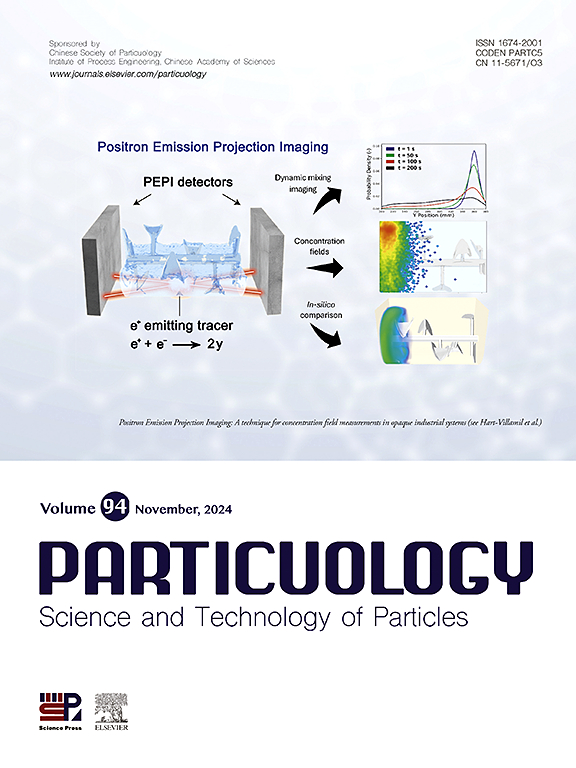Cutting-edge recycling solution at pilot-scale for end-of-life LiFePO4 batteries and recovery of graphite using centrifuge filtration
IF 4.3
2区 材料科学
Q2 ENGINEERING, CHEMICAL
引用次数: 0
Abstract
The rapid growth of the electric vehicle market has led to an unprecedented demand for lithium iron phosphate (LiFePO4) batteries, renowned for their exceptional safety, performance, and environmental benefits. However, the escalating volume of spent LiFePO4 batteries poses significant environmental and resource challenges. To address these concerns, this study develops an innovative industrial-scale recycling process utilizing centrifuge filtration to recover graphite assisted hydrometallurgy for efficient recovery of lithium, iron and phosphorus from LiFePO4 black mass powder (cathode powder + graphite). Hydrometallurgical acid leaching of LiFePO4 black mass powder is optimized under following conditions; 1.2 M sulfuric acid, 5% hydrogen peroxide, 100 g/L pulp density at 60 °C for 180 min reaction time in a 500 L reactor at pilot plant scale, achieving 99.7% lithium extraction efficiency and 93.5% fixed carbon in graphite residue. Metal composition and crystal structure were all revealed by extensive characterization utilizing atomic absorption spectroscopy (AAS), scanning electron microscopy (SEM), inductively coupled plasma optical emission spectroscopy (ICP-OES), x-ray diffraction (XRD) and particle size analyzer. This research provides a ground-breaking recycling pathway for LiFePO4 batteries, at pilot scale, promoting sustainable resource management, mitigating environmental risks, and supporting the circular economy. By leveraging centrifuge filtration-assisted hydrometallurgy, the recycling industry can efficiently recover valuable materials, reduce waste, and contribute to a more sustainable future.

中试规模的尖端回收解决方案,用于报废LiFePO4电池和使用离心过滤回收石墨
电动汽车市场的快速增长导致了对磷酸铁锂(LiFePO4)电池的空前需求,磷酸铁锂电池以其卓越的安全性、性能和环境效益而闻名。然而,废旧LiFePO4电池的数量不断增加,对环境和资源构成了重大挑战。为了解决这些问题,本研究开发了一种创新的工业规模回收工艺,利用离心过滤回收石墨辅助湿法冶金,从LiFePO4黑色粉末(阴极粉末+石墨)中高效回收锂、铁和磷。在以下条件下对LiFePO4黑色团状粉末的湿法冶金酸浸进行了优化;1.2 M硫酸,5%过氧化氢,100 g/L矿浆密度,60℃,500 L反应器,180 min反应时间,中试规模下,锂提取率为99.7%,石墨渣中固定碳含量为93.5%。利用原子吸收光谱(AAS)、扫描电子显微镜(SEM)、电感耦合等离子体发射光谱(ICP-OES)、x射线衍射(XRD)和粒度分析仪对金属成分和晶体结构进行了广泛的表征。本研究为LiFePO4电池提供了一条开创性的中试回收途径,促进了可持续资源管理,降低了环境风险,并支持了循环经济。通过利用离心机过滤辅助湿法冶金,回收行业可以有效地回收有价值的材料,减少浪费,并为更可持续的未来做出贡献。
本文章由计算机程序翻译,如有差异,请以英文原文为准。
求助全文
约1分钟内获得全文
求助全文
来源期刊

Particuology
工程技术-材料科学:综合
CiteScore
6.70
自引率
2.90%
发文量
1730
审稿时长
32 days
期刊介绍:
The word ‘particuology’ was coined to parallel the discipline for the science and technology of particles.
Particuology is an interdisciplinary journal that publishes frontier research articles and critical reviews on the discovery, formulation and engineering of particulate materials, processes and systems. It especially welcomes contributions utilising advanced theoretical, modelling and measurement methods to enable the discovery and creation of new particulate materials, and the manufacturing of functional particulate-based products, such as sensors.
Papers are handled by Thematic Editors who oversee contributions from specific subject fields. These fields are classified into: Particle Synthesis and Modification; Particle Characterization and Measurement; Granular Systems and Bulk Solids Technology; Fluidization and Particle-Fluid Systems; Aerosols; and Applications of Particle Technology.
Key topics concerning the creation and processing of particulates include:
-Modelling and simulation of particle formation, collective behaviour of particles and systems for particle production over a broad spectrum of length scales
-Mining of experimental data for particle synthesis and surface properties to facilitate the creation of new materials and processes
-Particle design and preparation including controlled response and sensing functionalities in formation, delivery systems and biological systems, etc.
-Experimental and computational methods for visualization and analysis of particulate system.
These topics are broadly relevant to the production of materials, pharmaceuticals and food, and to the conversion of energy resources to fuels and protection of the environment.
 求助内容:
求助内容: 应助结果提醒方式:
应助结果提醒方式:


